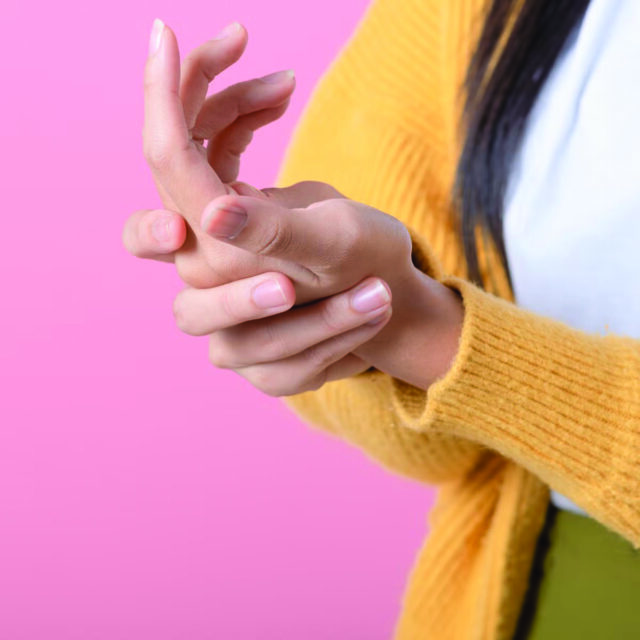If one (or more) of your fingers feel sore and stiff throughout the day—and extra-tender at the moment you open your eyes in the morning—you could be dealing with osteoarthritis of the hands.
For starters, osteoarthritis or OA (arthritis in hands) is a degenerative joint disease where the tissues in the entire joint break down, as defined by the National Institutes of Health (NIH). “It is a form of arthritis that is related to trauma to the joints, or overuse or repetitive activity to joints,” says Tamika Henry, M.D., M.B.A., a board-certified family physician and founder of Unlimited Health Institute. “Think ‘wear-and-tear’ of the joints.”
Inflammation causes the protective cartilage (the cushioning at the ends of your bones) to wear away—and overtime, the joints rub together and bring on pain, explains Ritu Madan, D.O., a rheumatology specialist at The Ohio State University Wexner Medical Center. “When we talk about osteoarthritis of the hands, it typically affects three parts of the hand: The base of the thumb, the small joints closest to the fingertips, and the middle joints of the finger.” In fact, the 29 bones of your hands and wrists come together to form many small joints that can be affected by OA, states the Arthritis Foundation.
Generally speaking, joint inflammation is a widespread condition. Arthritis is the number one cause of disability in the U.S. where it affects approximately 60 million adults, according to the Arthritis Foundation. The Centers for Disease Control and Prevention (CDC) states that 1 in 4 adults (or 58.5 million people) have been diagnosed with arthritis, which is more common in females. And OA of the hands will occur in nearly 50% of women and 25% of men by the age of 85, reports the Arthritis Foundation.
Risk factors
Certain inherent and lifestyle factors can increase your chances of developing OA of the hands.
Age: “This form of arthritis usually impacts older people, especially those older than 50,” says Levi Harrison, M.D., orthopedic surgeon, author, and motivational speaker.
Genetics: “Family history make someone more prone to developing it,” says Dr. Madan.
Sex and Race: Along with being female, caucasians are more likely to deal with OA of the hands compared to African Americans, according to the Arthritis Foundation.
Weight: OA in the hands has a higher risk of occurring in adults who are overweight or obese.
Health history: OA in the hands has been seen in individuals who have bone deformities, states Dr. Henry. “Also, someone who has suffered dislocated bones or broken fingers, perhaps playing baseball or another sport, would be more prone to developing hand arthritis,” adds Dr. Madan.
Pre-existing joint issues: Joint infections, loose ligaments, and poorly aligned joints can result in hand or wrist arthritis, reports the Arthritis Foundation.
Environmental: Working at a job where your hands make highly repetitive movements (such as a hair stylist, chef, artist, musician, or clothes manufacturer) could lead to OA of the hands, says Dr. Harrison.
Symptoms and triggers
Common complaints include pain, stiffening, limited range of motion, and swelling of the joints, explains Dr. Harrison. “Patients will often tell me they have difficulty opening jars and cans, or that their joint pain is worse in the morning,” he adds.
As time goes on, OA of the hands could cause a burning sensation or sharp pain after hours of using your fingers and hands, reports the Cleveland Clinic. Other long-term symptoms include changes in the joints, such as:
Swelling: The tissues surrounding the inflamed joints may lead to redness and tenderness, as well as feeling warm to the touch.
Cracking: A feeling of grinding, grating, or clicking, also known as crepitus or creaky joints, caused by the bones rubbing against each other when bending your fingers.
Nodules: Small, bony lumps may form on the middle joint of the finger (referred to as Bouchard’s nodes) or at the at the joint near the fingertip (known as Heberden’s nodes).
Cysts:
If arthritis develops at the end joints of the fingers, small, mucous cysts may develop and cause ridging or dents in the nail plate of the affected finger, according to the American Academy of Orthopaedic Surgeons (AAOS).
Joint deformity:
Due to bone changes, loss of cartilage, and joint swelling, the bones could become larger (known as hypertrophic).
OA in the hands could be exacerbated by certain triggers, such as stress, infection, rainy or cold weather, or extended use of the hands and fingers.
Home remedies: Since the main goal is to minimize inflammation in the body, quitting smoking, losing weight, resting your joints after a long day, eating an anti-inflammatory diet (which includes more plant-based foods and less alcohol/processed foods), and managing other inflammatory health conditions (such as cardiovascular issues or digestive disorders) may help reduce flare-ups,…
Source: prevention.com/health/
6.7
C
Vancouver
Wednesday, November 5, 2025




























